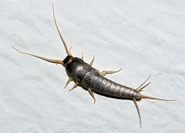 Silverfish and firebrats, are sometimes found in libraries, storage areas, bathrooms, basements and boiler rooms. They prefer dark, moist environments and feed on mold and the starchy pastes used in book covers and bindings, cardboard boxes, starched fabrics and wallpaper. These small, wingless, crawling insects are fast-moving, but stay close to their food source. They have three long, tail-like appendages about as long as the body, long antennae, and a body covered with silvery (silverfish) or mottled gray (firebrats) scales. Silverfish thrive in moist cool environments like basements. Firebrats prefer moist, warm places such as kitchens, boiler rooms and the insulation around steam and hot water pipes.
IPM Tactics for Silverfish and Firebrats
· Control Moisture: Repair leaks in pipes, radiators, and dripping faucets, maintain floor drains, eliminate standing water, use fans to ensure rapid drying after floors are cleaned, insulate sweating pipes, empty drip trays in refrigeration units and air conditioners;
· Control Humidity: ventilate closed rooms, attics, and crawl-spaces. Use a dehumidifier if needed.
· Eliminate Mold: Remove moldy and mildewed items such as moisture damaged books, boxes, fabrics, wallpaper, and insulation. Replace water-damaged ceiling tiles.
· Monitor: Place and monitor sticky traps to pinpoint where they are most active, then eliminate the food and moisture attracting them.
· Vacuum cracks and crevices with a narrow vacuum tip to physically remove these insects from their harborages.
· Eliminate Harborage Sites: Seal cracks and crevices with caulk, especially around windows, cabinets, and moldings. Increasing the lighting makes harborages less hospitable. Remove leaf litter from around the building.
If non-chemical methods alone do not solve the problem, contact a licensed commercial pesticide applicator. Lower risk pesticides such as diatomaceous earth or silica aerogel applied into cracks and crevices can be effective. Crack and crevice applications made by a licensed applicator do not require advance notice to parents and staff.
Adapted from: Pennsylvania School IPM Newsletter <http://extension.psu.edu/pests/ipm/schools-childcare/school-ipm-newsletter/school-ipm-newsletter-april-2015>
photo credit: Christian Fischer, CC BY-SA 3.0, https://commons.wikimedia.org/w/index.php?curid=28984904
|